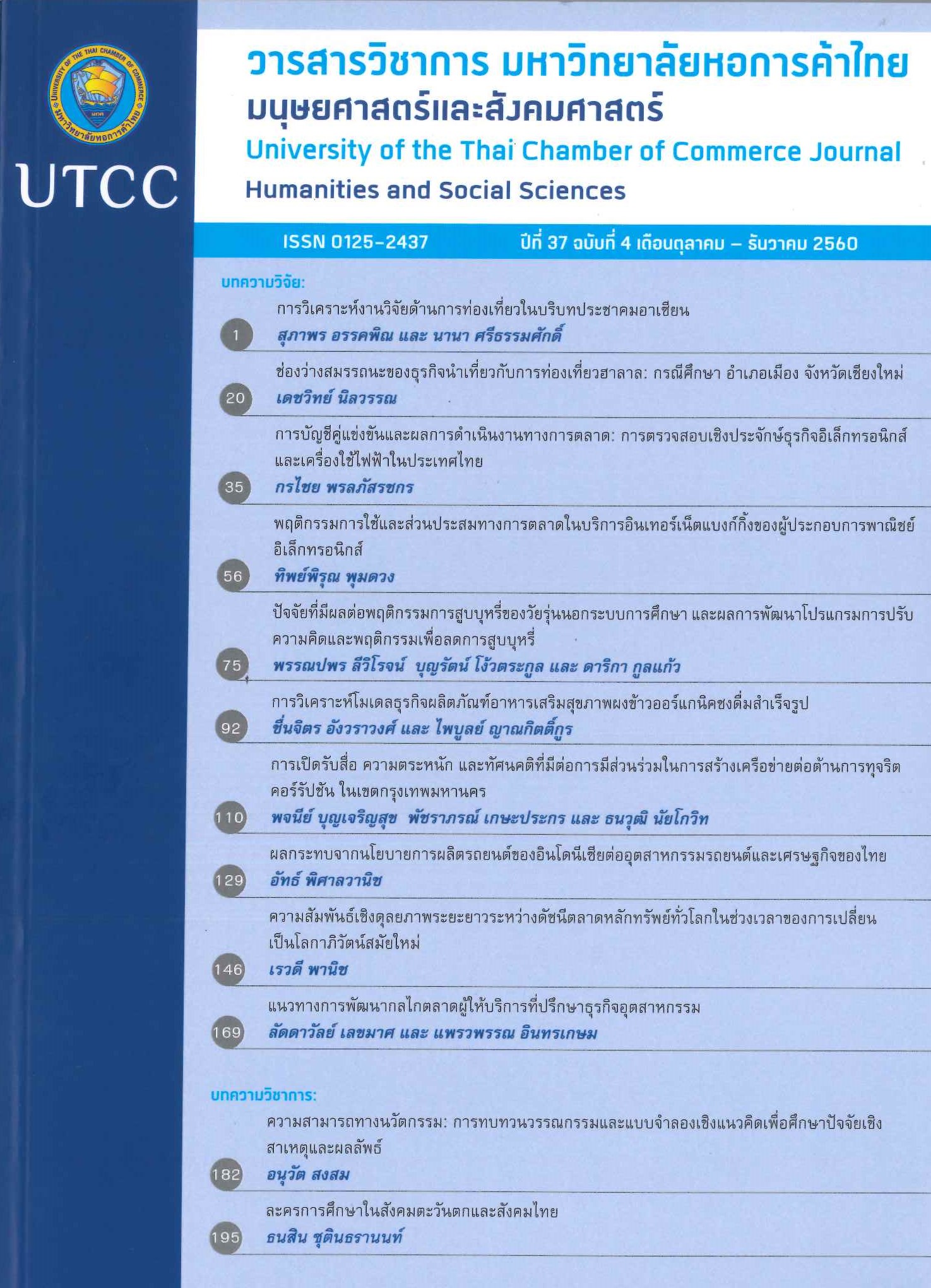Business Model Analysis of Health-Supplement Product from the Organic Rice-Powder Drink
Main Article Content
Abstract
This article aims to analyze the business model of organic rice-powder drink by studying and developing the product concept of healthy food made from grits and by-products of organic jasmine rice. Research design employs mixed methods, qualitative research and quantitative research. In addition, the concept is analyzed by using a Business Model Canvas that an appropriated tool covers with major factors on nine boxes; 1) customer segments 2) value proposition 3) communication and distribution channels 4) key resources 5) key activities 6) key partnerships 7) customer relationships 8) revenue streams) and 9) cost structure to analyze feasibility. As a result, the organic rice powder products which value-added from grits and by-products of organic jasmine rice that distinctive feature of products manufactured from organic materials, non-toxic, environmental-friendly. Moreover, the products will benefit for consumer health and increase revenue for farmers who produce organic rice.
Article Details
ลิขสิทธิ์ของบทความ
ผลงานที่ได้รับการตีพิมพ์ถือเป็นลิขสิทธิ์ของมหาวิทยาลัยหอการค้าไทย ห้ามมิให้นำเนื้อหา ทัศนะ หรือข้อคิดเห็นใด ๆ ของผลงานไปทำซ้ำ ดัดแปลง หรือเผยแพร่ ไม่ว่าทั้งหมดหรือบางส่วนโดยไม่ได้รับอนุญาตเป็นลายลักษณ์อักษรจากมหาวิทยาลัยหอการค้าไทยก่อน
References
Retrieved from https://www.hec.unil.ch/ aosterwa/PhD/Osterwalder_PhD_BM_Ontology.pdf
Ampuero, O., & Vila, N. (2006). Consumer perceptions of product packaging. Journal of Consumer Marketing, 23, 100-112.
Armstrong, G., & Kotler, P. (2007). Marketing: An introduction (8th ed.). Upper Saddle River, NJ: Pearson Education.
Azila Mohd Noor, N., Yap, S.-F., Liew, K.-H., & Rajah, E. (2014). Consumer attitudes toward dietary supplements consumption: Implications for pharmaceutical marketing. International Journal of Pharmaceutical and Healthcare Marketing, 8, 6-26.
Azzurra, A., & Paola, P. (2009). Consumers’ behaviours and attitudes toward healthy food products: The case of organic and functional foods. In The AAE seminar resilient European food industry and food chain in a challenging world (pp. 3-6). Chania, Greece: n.p.
Bank of Thailand. (2014). Thai agricultural products reported 2013-2014. Retrieved January 15, 2016, from https://bot.or.th (in Thai).
Charles, M. F., & Suzy, W. (1996). The ways chief executive officers lead. Harvard Business Review. Retrieved from https://hbr.org/1996/05/the-ways-chiefexecutive-officers-lead
David, J. T. (2010). Business models, business strategy and innovation. Long Range Planning, 43, 172-194.
Department of Provincial Administration, Office of the Federal Register. (2015). The number of people throughout the kingdom:Separate Bangkok and other provinces. Retrieved December 18, 2015, from https://ratchakitcha.soc.go.th/DATA/PDF/2558/E/049/11.PDF (in Thai).
Eamlaorpakdee, P. (2012). The value chain development of rice products. University of the Thai Chamber of Commerce Journal, 32(2), 120-128. (in Thai).
Ewa, H. (2012). Health and wellness the trillion dollar industry in 2017: Key research highlights. Retrieved January 12, 2016, from https://blog.euromonitor.com/2012/11/ health-and-wellness-the-trillion-dollarindustry-in-2017-key-research-highlights.html
George, D. (2016). 37 creative employee reward ideas (2016 update). Retrieved January 22, 2016, from https://blog.bonus.ly/15- creative-employee-reward-ideas/
Green Net Cooprative. (2014). The organic Thailand 2013-2014. Retrieved January 10, 2016, from https://www.greennet.or.th/article/411 (in Thai).
Heidi, M. B., Peter, A. K., & Ian, E. (2015). Business models outside the core lessons learned from success and failure. Research -Technology Management, 58(2), 20-29.
Jaroenwanit, P., Tongsokhowong, A., & Brahmasakha Na Sakolnakor, P. (2011). Product development and market testing for commercialization of OTOP in the northern region of Northeastern Thailand: Case study of non food and medicine products. Khonkaen, Thailand: Khonkaen University. (in Thai).
John, A. C., & Roger, A. K. (2009). Competitor analysis. Retrieved June 5, 2016, from https://pages.stern.nyu.edu/~jczepiel/Publications/CompetitorAnalysis.pdf
John, B. (2008). Core concepts of marketing. Retrieved January 18, 2016, from https://www.saylor.org/site/wp-content/uploads/2012/11/Core-Concepts-of-Marketing.pdf
Jonides, J. (2000). Notices and announcements. Psychobiology, 28 (4), 593-594.
Kapsak, W. R., Rahavi, E. B., Childs, N. M., & White, C. (2011). Functional foods: Consumer attitudes, perceptions, and behaviors in a growing market. Journal of the American Dietetic Association, 111,804-810.
Katenil, N. (2014). The behavior and attitude of consumers to health-food products in Thailand. Retrieved December 12, 2015, from https://fic.nfi.or.th/broadcast/TMK-Jan2014-FICOIE.pdf (in Thai).
Kotler, P. (2014). Kotler on marketing: How to create, win, and dominate markets. New York, NY: Free Press.
Kotler, P., & Keller, K. L. (2009). Marketing management. Retrieved from https://socioline.ru/files/5/283/kotler_keller_-_marketing_management_14th_edition.pdf
Lamphao, C. (2013). The study of attitude, perception and behavior on Korean trends (Unpublished master’s thesis). National Institute of Development Administration, Bangkok, Thailand. (in Thai).
Land Development Department. (2015). Database farmers use renewable organic chemicals. Retrieved January 2, 2016, from https://www.o-agriculture.ldd.go.th/ ldd/memBioNotReadyGroup.aspx (in Thai).
Lee, H.-J., & Yun, Z.-S. (2015). Consumers’ perceptions of organic food attributes and cognitive and affective attitudes as determinants of their purchase intentions
toward organic food. Food Quality and Preference, 39, 259-267.
Leelamanit, W. (2014). Using vitamins and supplements in the elderly. Retrieved December 25, 2015, from https://www.pharmacy.mahidol.ac.th/knowledge/files/0253.pdf (in Thai).
Office of the National Economic and Social Development Board. (2016). Economic and social statistics: The number of elderly in Thailand (1990-2040). Retrieved March 18, 2016, from https://social.nesdb.go.th/SocialStat/StatReport_Final.aspx?reportid (in Thai).
Reinhard, M., & Volker, S. (2015). Strategic product value management: How companies can improve innovation, reduce costs and mitigate risk. Retrieved January 12, 2016, from https://www.strategyand.pwc.com/reports/strategicproduct-value-management
Singhirannusorn, C., & Arloonmaung, A. (2013). Dietary supplement product consumption behavior of secondary school students under Supervision Region 2 of Ministry of Public Health. FDA Journal, 20(1),38-47. (in Thai).
Tongwassanasong, N. (2016). Buying decision process of non-alcoholic beverage in modern trade store of consumers in the Nonthaburi province. University of the Thai Chamber of Commerce Journal, 36(2), 99-106. (in Thai).
United Nations. (2015). World population prospects: The 2015 revision. Retrieved March 14, 2016, from https://esa.un.org/unpd/wpp/publications/.../WPP2015_DataBooklet.pdf
Willer, H., & Lernoud, J. (2014). Organic argriculture worldwide: Current statistics. Retrieved January 12, 2016, from https://www.fibl.org/fileadmin/.../de/.../2014/willer2014-global-data.pdf
World Health Organization. (2014). World health statistics. Retrieved January 12, 2016, from https://apps.who.int/iris/bitstream/10665/..112738/1/9789240692671_eng.pdf
Zhenya, L., Martin R., George S., & Martin, S. D. (2009). Business model innovation. Retrieved January 2, 2016, from https://www.bcg.com/documents/file36456.pdf

